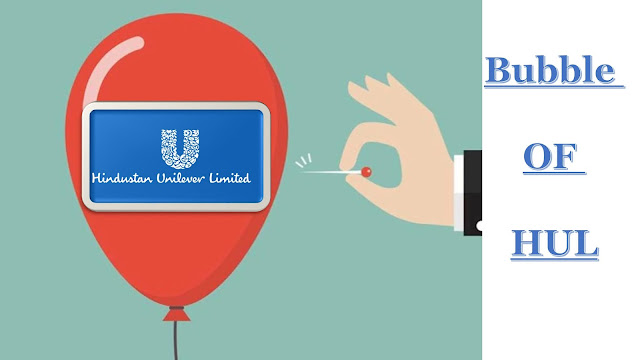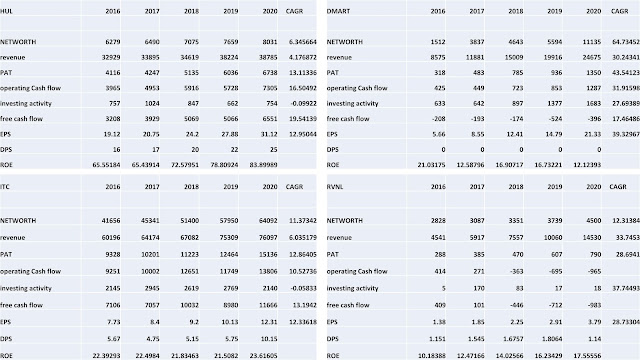The bubble
of HUL
Article published as on Saturday, 10th October,
2020 at 1:00 p.m.
Introduction
Does Hindustan unilever (HUL) share deserve the
current valuations?
Would HUL share price underperform in coming years?
While I was reading I came across articles stating
how ITC could be better than HUL, so I did my own research to confirm this and
here it is.
Flow of the article
>Introduction
>Explaining flow
>PE ratios and financial data of companies.
>Using DCF valuation method (no calculations
only figures)
>COE (cost of equity) better than return on equity and flaws of current methodology of calculation.
>Finding value through this new method.
>Comparing HUL with global counterparts in terms
valuations.
>Conclusion
Let me provide my case and research to you
PE ratios
and financial data of companies.
Hindustan unilever’s PE is high.... (Compared to index)
[Stock price /PE (TTM)]
HUL 2138.85 /73.21
Dmart 2057.65 /125.26
Verses
(Benchmark)
SENSEX 40509.49 /23.32
ITC ltd 167.85 /14.42
RVNL 18.70 /4.98
(Rail vikas nigam ltd)
Let’s check
the growth rate of all these companies in last 5 years.
After gathering data
Using DCF valuation
method
For
Fair value for HUL 785
rupees/-
Fair value for ITC
179 rupees/-
We can use DCF only for positive free cash flow
companies such as ITC and HUL.
(For dmart and rvnl they are using capital for
growth hence we currently won’t be using DCF for them)
As we can see I had taken 19.54% growth for HUL (on
a higher side)
And 13.19% growth for ITC.
These valuation is for getting 15% return on equity
(discounting rate taken as 15%)
And the results are before you.
Better thing
to use instead of ROE could be COE
The formula for ROE
1) ROE = net earnings (PAT)/ average shareholders’ equity
(net worth)
Return on equity is the amount the book equity
generates as net profits
(Here calculations are made on net worth which can
be misleading, example given below)
Interesting Example: Suppose I BUY a debt security for rupees 100
which yields me 7% rate of return I write off 93 rupees in my books and show
its value as 7 rupees of debt security which yields me 7 rupees.
I would say Look at this wonderful security earning
100% ROE, buy this 70 times P/E (490 rupees)
This way I quote 100 rupees of fair value of debt
security for 490 rupees.
Problem here is that I cannot reinvest that 7
rupees interest for same 100% return.
This is what
is happening in Hindustan Unilever
Some people say ‘OH look at its incredible high
Return on equity!’
But the problem is that HUL cannot reinvest that
money to get compounding growth effect.
Now ROE can be misleading instead lets understand
what is it and how to calculate cost of equity
Cost of
equity for investor is the rate of
return s/he expects on investment, for the company it is the cost of raising
fund through equity.
It is much more dynamic in nature due to its
flexible formula.
Cost of equity= risk free rate of return+ premium
expected for risk
1) COE= (Dividend/ share price) + growth
2) COE= (Earnings/share price) + growth
COE for all the companies are as follows based on their
share price
(As on
9/10/20)
Stocks share price/ Cost of equity
HUL 2138.85 /1.3659 %
Dmart 2057.65 /0.7983 %
ITC ltd 167.85 /6.9348 %
RVNL 18.70 /20.0803
%
Now lower the COE, the more attractive for company
to raise funds using equity dilution.
And higher the COE, the more attractive for company
to buy back its shares
From the data it’s evident that HUL pays out major
portion of its EPS as dividends and is not able to reinvest in its business. So
despite having such low COE it won’t be taking advantage of this phenomenon
For this dividend pay-outs let’s take it as ‘interest
from fixed income security’ and calculate its fair value.
Five year forward dividend is expected to be 45.95 [25*(1.1295^5)]
assuming 6% yielding debt security (10 year G-sec
yield is around 6%) it comes to around 766 rupees.
Counter argument:
If HUL is high PE stock, then other FMCG
companies also trade at high PE then are they overvalued too?
We can’t be using this formula for all FMCG
companies as not all of them pay all of their income as dividend.
This is the
#1 reason why I feel HUL is overvalued.
Because it pays almost all its income as dividend
and is not able to reinvest into its business.
Some People suggest that it has high growing
business.
Just because PE is high people will try to justify
it by saying high growth business.
It has growth, but other companies are also growing
which are available at reasonable valuations.
Another
interesting study comping HULS valuations to its global peers:
Let’s compare at what valuations do its global peer’s
trade at?
(Stock price (currency) P/E)
Hindustan unilever 2138.85
INR/ 73.21
Unilever (UK) 4847
GBX/ 23.73 P/E
Unilever Pakistan foods ltd 15000 PKR/ 29.12 P/E
Glaxo smithKline Bangladesh ltd 2174.90 BDT/ 29.12
P/E
(GSK Bangladesh is taken because just like in India
GSK sold its business to HUL in share swap transaction, similarly in Bangladesh
also its business is under process of being sold to Unilever, hence it is taken
for comparison)
Now as we see among all the Unilever’s our Hindustan
Unilever is trading at much higher premium.
One may argue that geography, market
size and opportunity is different…
Well this is just a broad comparison which we have
to take with a pinch of salt.
And for people interested, they should dig deeper
whether Hindustan unilever really is growing faster than its Pakistani and Bangladeshi
counterpart.
As a matter of fact I just checked the data of year
ending 31st Dec 2015 and 2019 and saw that Unilever Pakistan foods
ltd has grown faster than its Indian counterpart yet its trading at cheaper
valuations…
🙋Now someone will try to bring in inflation point of
view into it
🤣🤣😂😂😆😆 Enough of analysis!!!
I will leave it to you, Comment down to share your
thoughts on it
Conclusion
>I have repeated several times and once again I would
repeat that HUL seems overvalued because
it’s not reinvesting into its business and giving almost all of its income
as dividend.
>I am buying High P/E stocks for growth and not
just dividend otherwise I would be better off owning stock like PFC, REC
>In the long term stock prices corrects towards their
fair value/ intrinsic value
>There was a time when HUL did not move for
years and suddenly a spurt came and made investor’s wealthy
>Currently price of ITC is similar to what
it was 8 years ago.
>So in the next 10 years it’s more likely that HUL will underperform ITC*
*ITC is just taken for comparison with HUL there
are other growth oriented stocks such as dmart and RVNL (psu) and many more
which could outperform the returns of Hindustan Unilever (HUL)
(Disclosure: I don’t own HUL or ITC, they seemed an interesting case to me, and I have just presented my viewpoints here.)




ConversionConversion EmoticonEmoticon